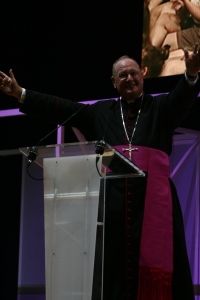
Archbishop Timothy Dolan welcomes pilgrims at the beginning of cathechesis at the Love and Life Center.
Despite arriving home very late the night before, on Friday morning we were up and out the door by 9 a.m. to make our way to the Life and Love Center in Madrid for the morning’s catechesis. We had heard it would be delivered by Archbishop Timothy Dolan, the archbishop of New York and former primate of our neighboring Archdiocese of Milwaukee.
It was an easy bus ride in to Madrid, where we caught the metro. As usual, it was packed with the many pilgrims from around the world, each group going to their own destination.
At the Love and Life Center, we arrived just as Archbishop Dolan was making his way through the crowd at the front entrance, pumping hands and smiling as he was greeted enthusiastically by young Catholics.
We arrived in time for some praise and worship music, which the English-speaking crowd here welcomed with cheers and flag-waving. Just as easily, we were led into a more contemplative mood by a more meditative song, and we were introduced to Archbishop Dolan by a pair of youth group leaders.
He had come to deliver the third of the three catecheses, which followed the theme of this World Youth Day: “Planted and built up i9n Jesus Christ, firm in the faith.” On Wednesday, we had learned how we should be firm in the faith. On Thursday, we learned how to be rooted in the faith. Archbishop Dolan shared with us the results of that. We are called to share our firm faith, our rootedness in Jesus Christ with everybody, he said.
“This is what we call the missionary spirit of our faith, and what we call evangelization,” Archbishop Dolan said.
The faith, he said, is contagious. “We are itching to give it away; we are bursting to share it with others.”
What better example than this is the missionary spirit of Spain, who brought the faith to the American continent, who passed on the teachings of St. James and St. John from generation to generation before expanding it in the Age of Exploration.
How can we be missionaries and evangelists, the archbishop asked. He gave four ways: charity, joy, hope, and love for the Church.
First, charity: the archbishop explained that, from the very beginning of the Church, it was this charity, this love for others, that drew people.
“What really served as a magnet,” he said, “was the love the followed of Jesus Christ had for one another.”
When the martyrs would go to the lions rather than deny their faith, those who saw it realized that this love for God was so perfect, so depp, so passionate, so all-consuming that they would rather die than forfeit that love of God.
Bless John Paul II, the archbishop continued, called it the “law of the gift”: that we are all our best when we are most how God the Creator intended us to be. We are most nobly human when we give ourselves away in love to others.
“That’s the law you and I are called to obey,” the archbishop said. “That’s the first way we are called to be missionaries of Jesus Christ.”
The second way in which we are called to evangelize is through joy. When we are happy, other people want to know why, the archbishop said.
“That means, if they look deep enough, they’ll find Jesus Christ, because God is the source of our joy,” he said.
The third aspect of evangelization is through hope, the archbishop said. It is not chance that the first encyclical of Pope Benedict XVI was “Spe Salvi,” he said.
Hope is a powerful tool of evangelization. “When the world sees us never losing our hope, they want to know why,” the archbishop said. “Always be ready to give the reason why.”
The fourth mode of mission the archbishop presented was a passionate love for the Church.
The Church is Christ, he said, one, holy, and apostolic. A Catholic is one who believes that Jesus Christ remains alive and active in his Church.
This is tough lesson today because the polls tell us, the experts tell us, “heck, even the people in our family tell us,” he said, “they want spirituality without a religion. They want Christ without his Church, and we say, ‘No can do.’ That is an impossibility for a Catholic, because Jesus Christ and his Church is synonomous.”
At times, this is difficult. We see the Church in its brokenness, in the sin of its people, in scandal. But it is the same as the body of Christ on the cross, in its suffering state.
“The Church, in her most human side has a sinful, scandalous side,” Archbishop Dolan said, “but it is also divine.”
Now, this passion, this love of the Church, which is the passion of our lives and how tough it is today, he said, to show that allegience to the Church is a great missionary activity.
He told the story of a church in the Archdiocese of Milwaukee that was being closed, and how, when everything had been taken from it and it was no more than a wooden frame, the parishioners wanted to burn it down to prevent any sacrilege that might come to an empty, abandoned church. The fire was so strong, he said, that when he came by the next morning, on the edges of where the church had been were piles of nails, stacked where they fell as the wood burned. He picked up one of those nails, the sign of what held that 150-plus-year-old church together, and realized its metaphorical significance.
“We are heirs to the nails,” he said. “We are heirs to the wounds of Jesus Chris on the cross. The body may be bloody, he said, but the nails of Jeuss Christ keep the Church of Christ together.”

